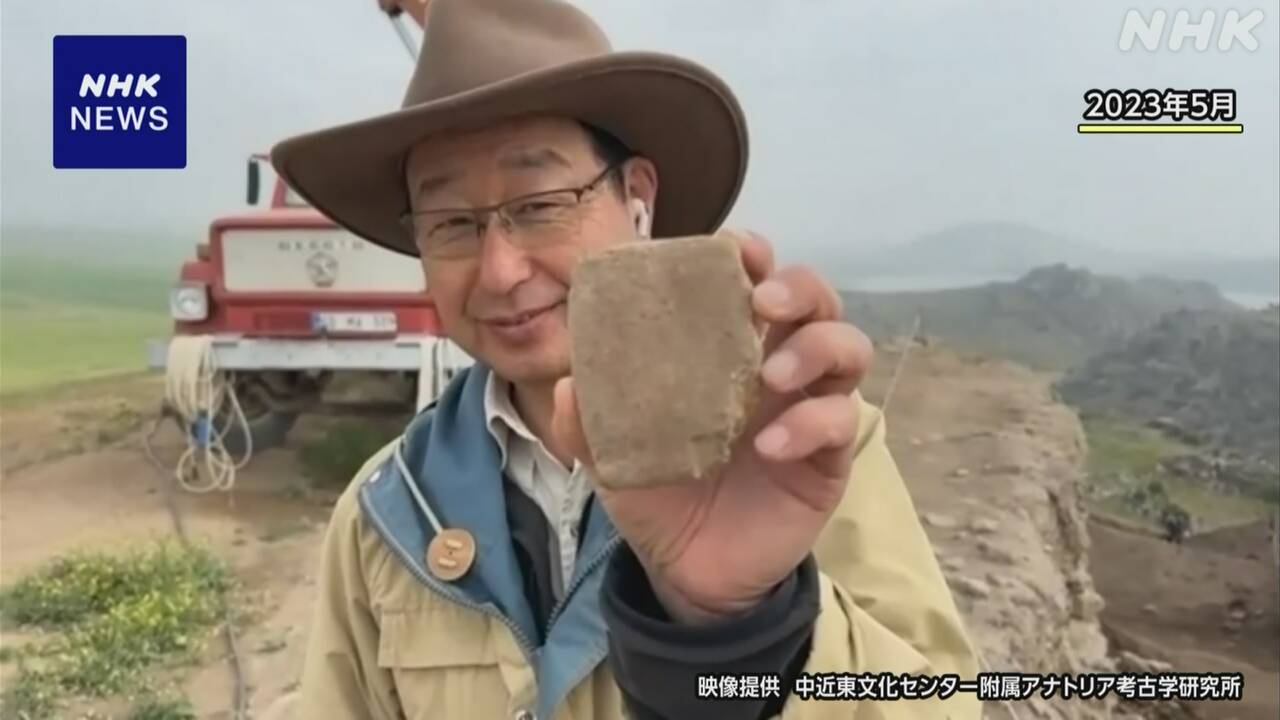A Japanese research team has excavated an almost complete clay tablet from an ancient ruin in Turkey that is thought to belong to the Hittite Kingdom, which was a powerful kingdom in what is now the Middle East more than 3,000 years ago.
In addition to Hittite, the clay tablets were also inscribed with Hurrian, a language said to have been used in national religious ceremonies, and the researchers who excavated the site said, ``This suggests that this site was an important city in the kingdom.'' "It's what you do."
The clay tablets were excavated at the Buklukale ruins in central Turkey.
For the past 15 years, a Japanese research team led by Kimihito Matsumura, a researcher at the Institute of Anatolian Archaeology, affiliated with the Middle East Cultural Center, has been conducting research at this ruins.
Last May, a palm-sized clay tablet with 70 lines of cuneiform inscriptions was found in almost complete condition on the north side of the ruins.
Based on the shape of the letters, the clay tablets are thought to date from the time of the Hittite Kingdom around the 14th century B.C., approximately 3,300 years ago.In addition to the Hittite language, the tablets also contained a language called Fuli, which was used in religious ceremonies at the time. It was carved.
Clay tablets written in the Hurrian language have only been found in the ruins of important cities such as Hattusha, the capital of the kingdom, and this discovery indicates that this city was also an important city with strong ties to the royal family. I mean, it's hinting.
Researcher Matsumura says, ``Until now, we didn't know what kind of city Buclucale was, but if it was an important city, we can expect further discoveries that will reveal unknown history.''
The contents of the clay tablet
The Buklukale ruins are located about 60 kilometers southeast of Turkey's capital Ankara, and in addition to the Hittite kingdom, excavated artifacts from a long period of time, from the Bronze Age 4,200 years ago to the Ottoman Empire, are found there. Although it has been confirmed, the clay tablets found this time are thought to date from the Hittite Kingdom around 14th century BC, approximately 3,300 years ago.
The first six lines of the 70-line text inscribed on the clay tablet read in Hittite, ``Four cities, including the capital Hattusha, are in disaster.''
Then, in the part that is thought to be the main text, there are inscriptions in another language called ``Hurri'' that include the name of the king of a rival neighboring country and a prayer to the supreme god ``Teshob''.
Huli was the language spoken in the countries to the east of the Hittites, and it is said that the Hittite king at that time took his wife from one of these, Kizwatna, in a political marriage.
It is thought that during this process, the religion of this country was adopted, and that Furi language came to be used in religious ceremonies.
It is believed that at the time the clay tablets were carved, the Hittite kingdom was under invasion from a neighboring country, and the research team believes that the Hittite kingdom may have prayed to God as a religious ritual to escape the danger of invasion.
Kimihito Matsumura, a researcher at the Institute of Anatolian Archaeology, who led the Japanese expedition, said, ``The archives were all destroyed by the people of the subsequent era, and the only clay tablets that have been uncovered so far are small fragments. "It was only last year, more than 10 years after excavations began, that for the first time, clay tablets were found in almost perfect shape," he said, looking back on the discovery.
Pre-Hittite geological strata have also been confirmed at the Bukryukale ruins, and researcher Matsumura said that excavation work would require a much longer period of time, saying, ``I don't think our generation will be able to reach the point where this is sufficient.''Researcher I want to develop my skills and pass the baton successfully.''
Researcher Matsumura will hold a report meeting on the 3rd of next month at the Tokyo National Museum in Ueno, Tokyo.
Expert: ``The ruins may have been a very important city of the Hittite kingdom''
Meng Yamamoto, a lecturer at Yamaguchi University who is an expert on the Hittite kingdom, explains the significance of the discovery of the clay tablets: ``In the latter half of its history, the Hittite kingdom actively incorporated the religions of its neighboring countries to the east, which spoke the Huli language, and developed their beliefs and myths. However, it seems to have been limited to the royal family and the royal family.The fact that the Hurrian language was inscribed on clay tablets indicates that there was a connection between the city in this ruins and the royal family of the Hittite kingdom. It is thought that there were strong ties.The era when this clay tablet was carved was a time when the Hittite kingdom was weakening, and the strong ties with the royal family at that time means that this ruin was a very important city of the Hittite kingdom. It may have been."
Furthermore, it is known from contemporary Egyptian diplomatic documents that the Egyptian pharaoh was planning a political marriage with the country of Arzawa, which was in conflict to the west of the Hittite kingdom. A name believed to belong to the king of the Hittite Kingdom has also been found, and this city, located at the westernmost edge of the Hittite Kingdom's territory at the time, may have been able to withstand attacks from enemies. It became a major power in the Oriental world in later times, and I believe that this ruin and the clay tablets found here will be important in thinking about how it became such a power." Ta.

